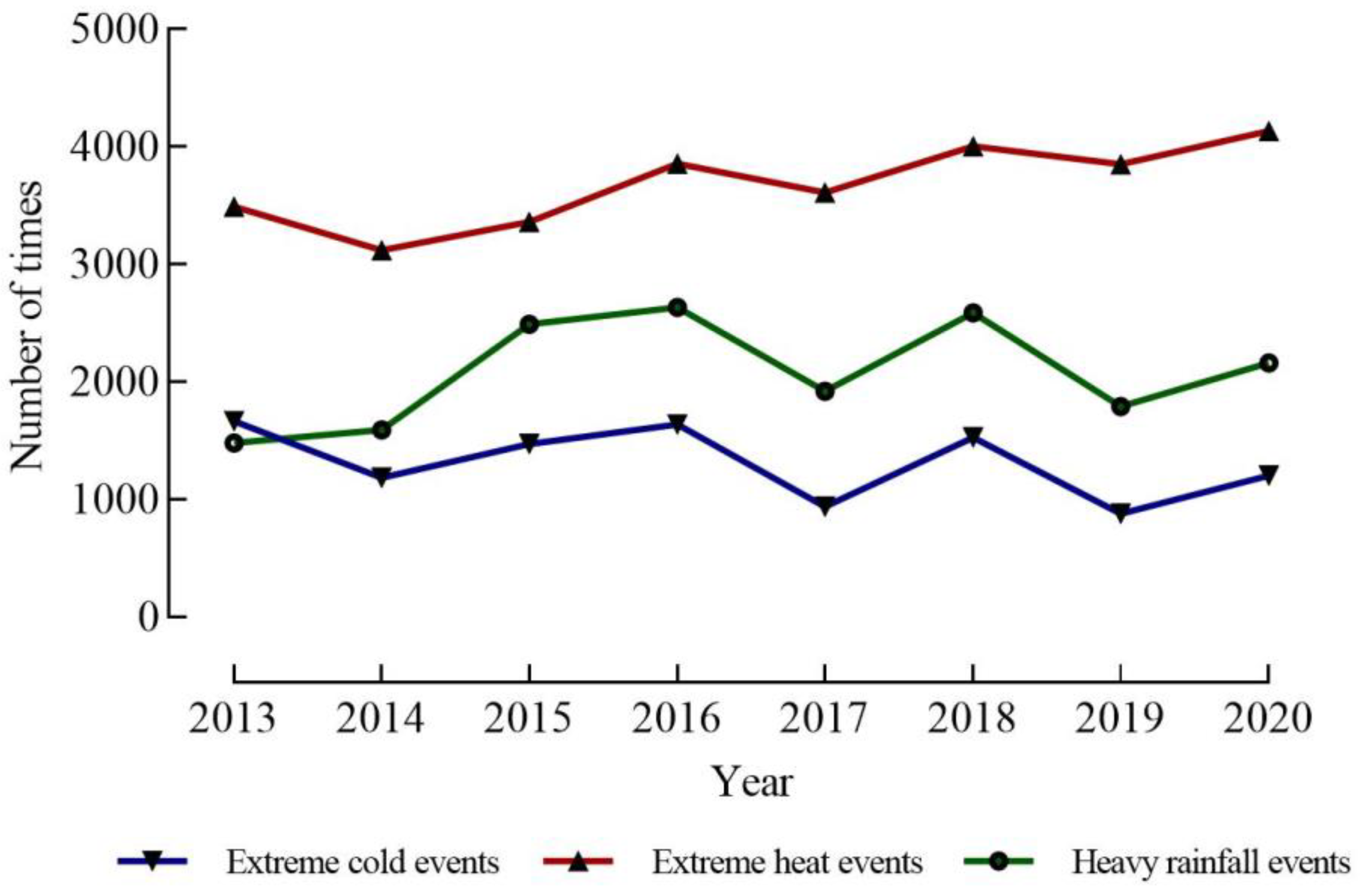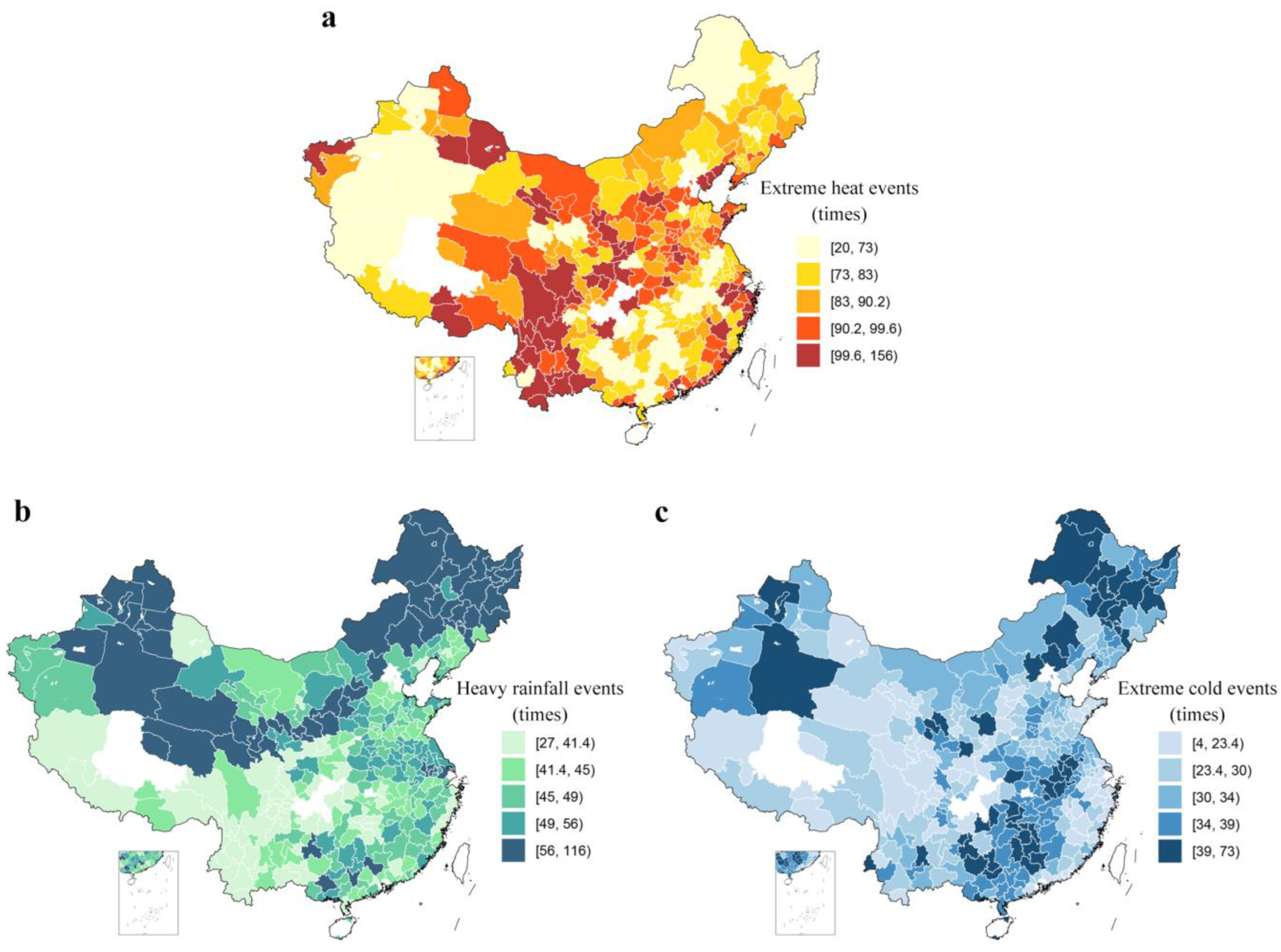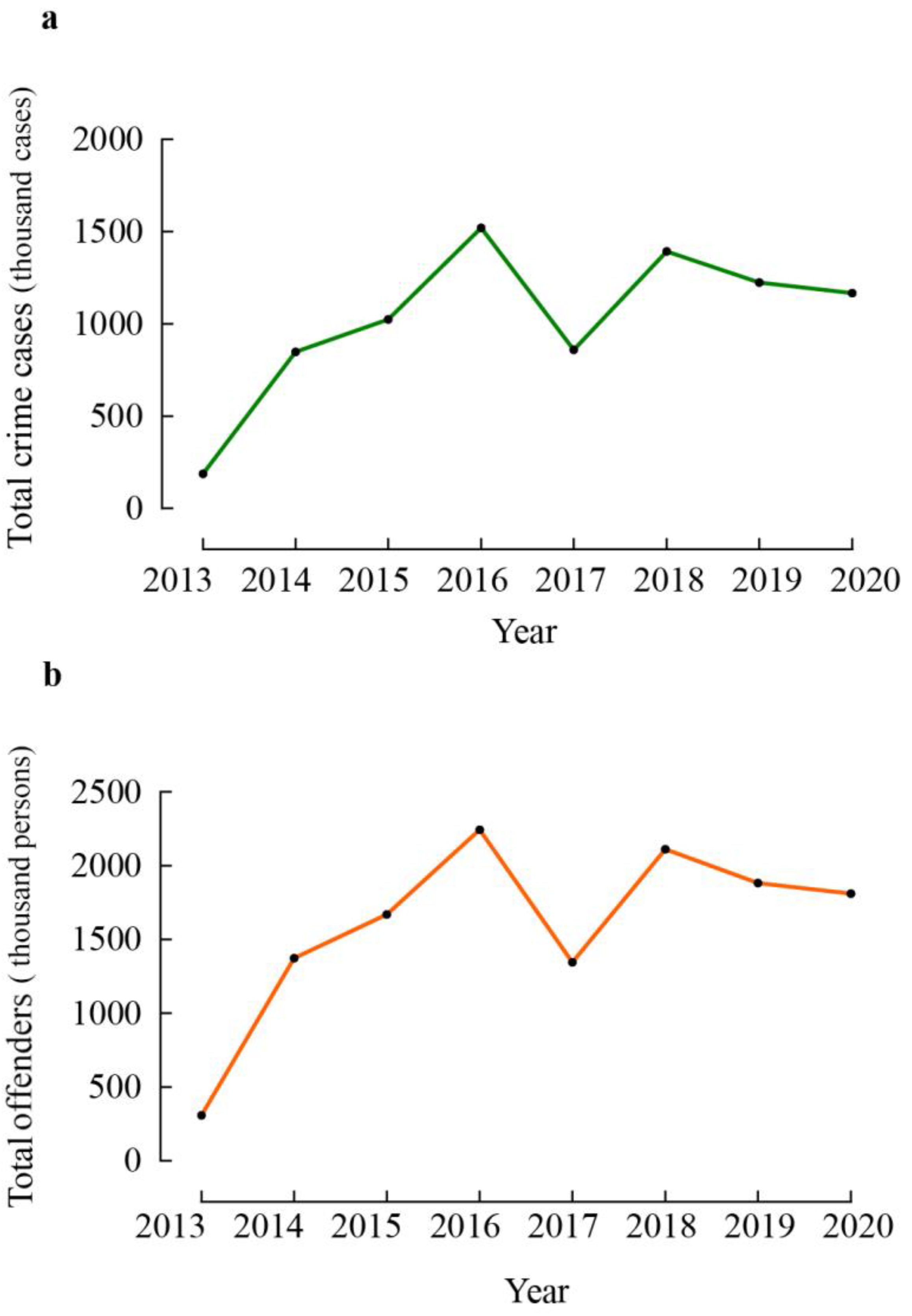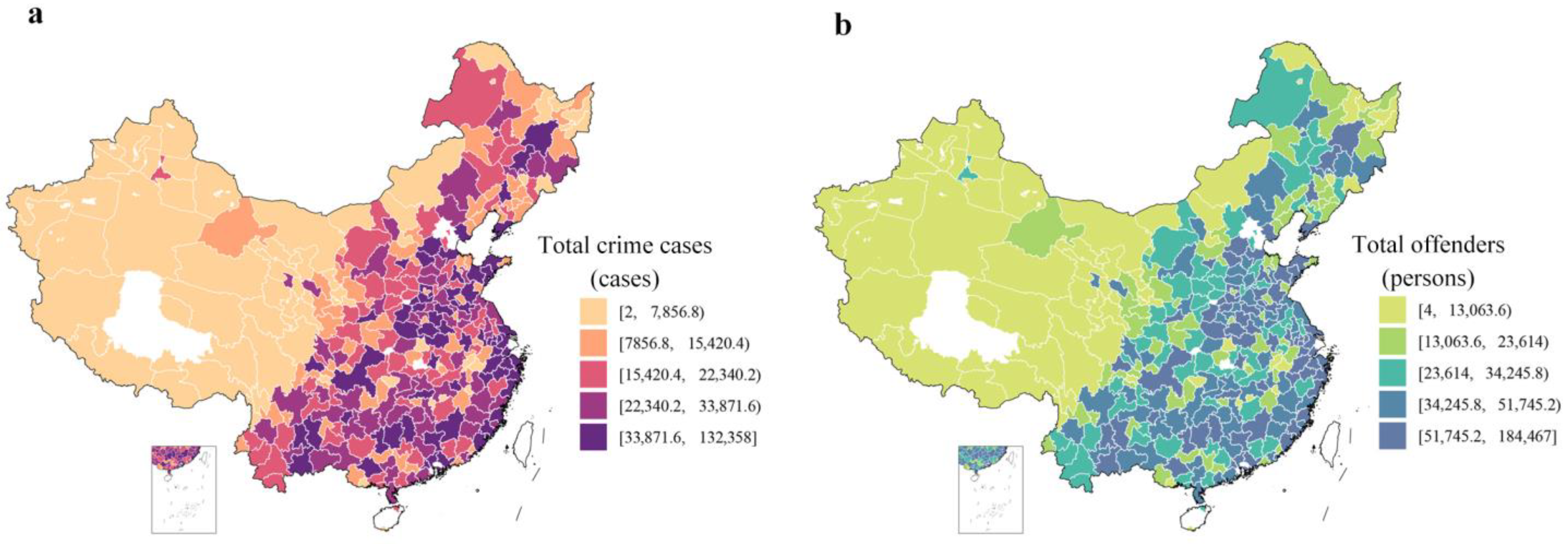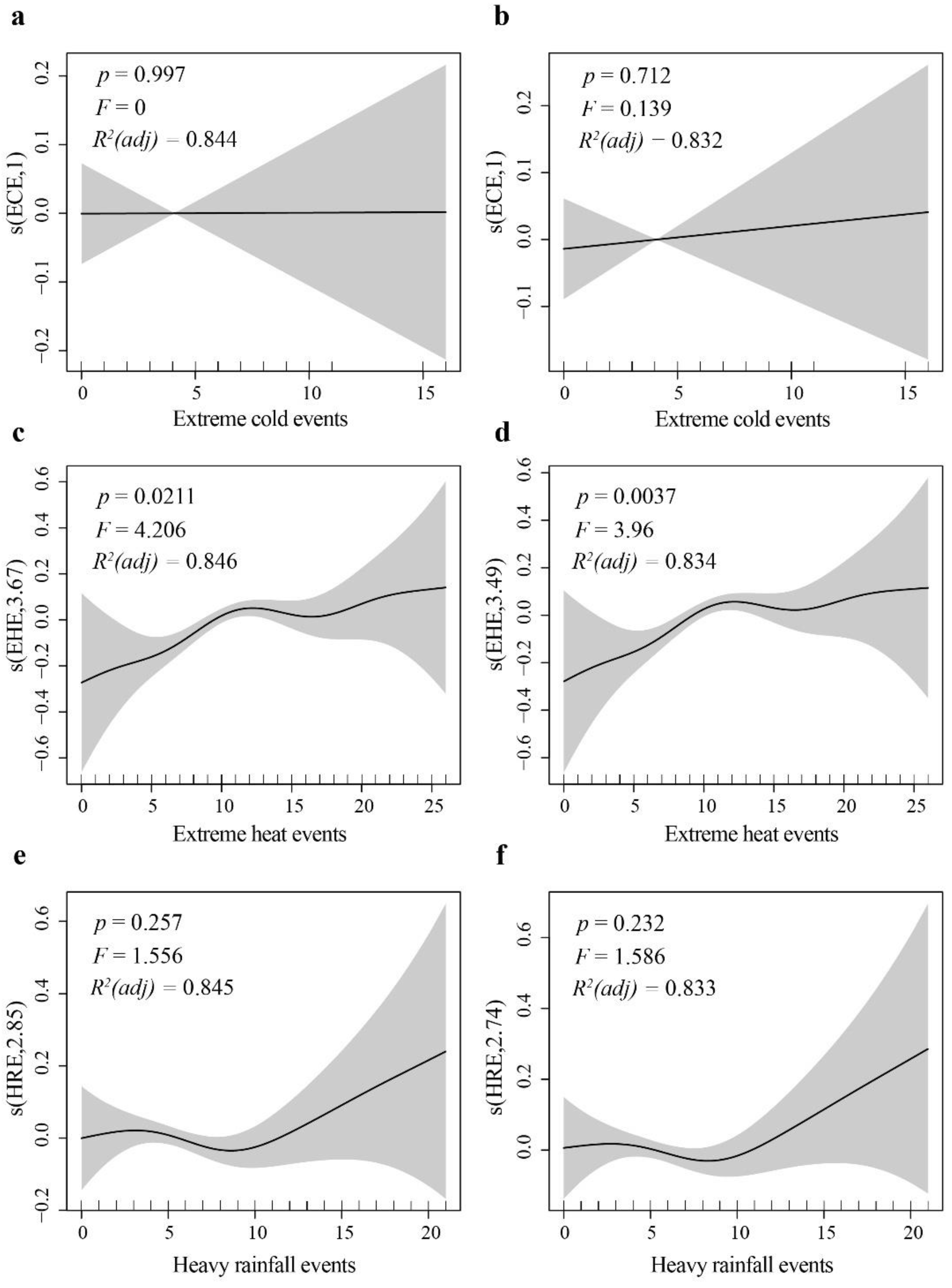1. Introduction
Climate change has become one of the most pressing global challenges of the modern era, manifesting in persistent global temperature increases, a rising frequency of extreme weather events, and significant shifts in precipitation patterns [
1]. According to the China Meteorological Administration’s global surface temperature dataset, the global average temperature from 2014 to 2023 was 1.2 °C higher than pre-industrial levels, marking the highest recorded temperature since 1850 [
2]. This trend suggests a continuous warming of the global climate, accompanied by an increased risk of extreme weather events [
3,
4].
In China, a region particularly sensitive to climate change and significantly affected by its consequences, the frequency and intensity of extreme heat and heavy rainfall events have been increasing [
2]. Long-term climate observations indicate that from 1961 to 2023, the occurrence of extreme heat events in China has risen sharply, with 2022 recording the highest frequency of such events since 1961 [
2]. These extreme heat events have not only become more frequent but have also intensified and lasted longer. As rising temperatures increase atmospheric moisture-holding capacity, the frequency and intensity of extreme heavy rainfall events have also intensified. Projections suggest that under the ongoing global warming trend, extreme heat events in China will continue to increase over the next 30 years [
2]. The average maximum extreme temperature in different regions is expected to rise by 1.7 °C to 2.8 °C, with the most pronounced increases in East China and western Xinjiang. Additionally, the average number of extreme heatwave days in China is expected to increase by 7 to 15 days. Under a high-emission scenario, extreme heat events that currently occur once every 50 years may become annual or biennial occurrences by the end of this century.
Beyond the physical manifestations of climate change, it is equally important to consider its psychological and behavioral effects on individuals. Extreme weather events, such as high temperatures and heavy rainfall, have profound impacts on agricultural production, energy supply, infrastructure operations, and social stability [
5]. They may also serve as key triggers of social disorder, as individuals are more frequently exposed to various stressors under extreme weather conditions, leading to heightened emotions of anger, confusion, and fear [
6]. These negative emotions can impair rational decision-making and may drive individuals to engage in actions that disrupt social order, with crime being perceived as a coping mechanism to alleviate or escape stress [
7]. The root of this stress often stems from difficulties in adapting to extreme weather conditions. For instance, high temperatures have been linked to sleep deprivation, mood fluctuations, and psychological distress—factors closely associated with violent behavior [
8,
9,
10,
11,
12]. The Generalized Temperature–Aggression Hypothesis [
13], grounded in physiological and psychological perspectives, posits that temperature is a crucial environmental factor influencing human emotions and behaviors. This hypothesis suggests that high temperatures increase physiological stress—such as elevated heart rate and blood pressure—making individuals more prone to hostile emotions. Moreover, heat exposure negatively affects psychological states by increasing irritability and dissatisfaction, which in turn heightens the likelihood of aggressive behavior. Additionally, extreme weather events can exacerbate stress through physical injuries, property damage, housing destruction, and livelihood disruptions, compelling individuals and families to adopt risky or illegal means to cope with adversity [
14,
15,
16]. Warm weather can also intensify social interactions, leading to greater crowding and disputes, which in turn increase the likelihood of outdoor violence [
17,
18]. For example, individuals are more likely to go out and consume more alcohol during hot weather, potentially contributing to heightened aggression [
19,
20]. Moreover, extreme weather events can reduce law enforcement capacity, further increasing both crime opportunities and the potential rewards of criminal activity [
6,
21]. These complex pathways highlight the potential link between extreme weather and crime, emphasizing the necessity of more effective social governance policies to mitigate the public security risks posed by extreme weather events.
The relationship between extreme weather and crime has increasingly become a focus of academic research, with numerous studies using daily, monthly, and annual panel data to examine the link between weather conditions and crime [
22]. A growing body of evidence consistently finds that interpersonal violence increases with rising temperatures and, in some cases, with decreased precipitation [
23,
24,
25]. This effect is evident not only in low-level aggressive behaviors—such as mistreatment of service workers and increased use of profane language on social media—but also in serious violent crimes, including rape, homicide, robbery, and assault [
26,
27]. Ranson, M. [
7] used a 30-year monthly panel dataset and found that rising temperatures in the United States led to increases in homicides, rapes, assaults, robberies, burglaries, thefts, and motor vehicle thefts. Hu et al. [
28] examined the effects of heat stress on violent and non-violent robberies in Beijing, China, and found that robbery patterns shifted under the influence of environmental factors, further affected by the social dynamics surrounding major events such as the 2008 Beijing Olympics. Both violent and non-violent robbery rates significantly increased with spring heat stress, while non-violent robberies also rose during summer heat stress. Meanwhile, in impoverished agricultural regions, such as rural India, anomalies in rainfall patterns have been shown to significantly affect crime rates, likely due to the role of agricultural output declines as a mediating factor [
29].
However, studies examining the impact of extreme weather on crime in China remain relatively limited. This is largely due to the long-standing constraint of crime research in China, which has been hindered by the lack of comprehensive crime data. To address this gap, this study estimates extreme weather events at the prefecture level in China from 2013 to 2020 using climate statistics and historical climate data. The analysis covers all 333 prefecture-level administrative divisions (including cities, autonomous prefectures, and leagues), with both urban and rural areas within their jurisdictions accounting for approximately 85% of China’s total population according to the 2020 Chinese National Census. Furthermore, information was extracted from 8.6 million criminal case verdicts published on the China Judgments Online platform between 2013 and 2020 through machine learning-based text analysis. Based on the location of the cases and the year of judgment, datasets on total crime cases and total offenders for prefecture-level divisions were constructed. This approach allowed for an investigation into whether extreme weather events are correlated with crime across Chinese prefectures.
The key innovation of this study lies in the use of a novel data construction method, which enriches research on the relationship between extreme weather and crime while providing empirical evidence from China. Specifically, machine learning-based text analysis was employed to extract crime data from court verdicts, overcoming the limitations of traditional crime data collection and offering a new data source and analytical tool for social science research. Moreover, by integrating methodologies from meteorology, criminology, legal text analysis, and machine learning, this study not only expands the boundaries of climate change impact research but also establishes a methodological framework for future studies in this field. The findings offer valuable insights for both potential perpetrators and policymakers by clarifying how extreme weather influences criminal behavior. They provide a scientific foundation for mitigating weather-induced stress and for developing climate adaptation policies and social governance strategies.
4. Conclusions and Policy Implications
This study analyzed the temporal trends and spatial distribution of extreme weather events, total crime cases, and total offenders at the city level in China. Subsequently, the effects of extreme heat, extreme cold, and heavy rainfall events on total crime cases and total offenders were examined using a fixed-effects quasi-Poisson regression model and a negative binomial regression model. Finally, given the complexity of this relationship, a generalized additive model was applied to estimate the nonlinear effects of extreme weather events.
Extreme weather events exhibit a significant positive correlation with both total crime cases and total offenders, although the effects vary across different types of weather conditions. The results from the quasi-Poisson regression and negative binomial regression confirm that extreme heat events have a significantly positive effect on both crime measures. In contrast, extreme cold events and heavy rainfall events do not show statistically significant effects on crime.
Extreme heat events demonstrate a notable nonlinear relationship with criminal activity. The GAM estimation results reveal that extreme cold and heavy rainfall events do not exhibit significant nonlinear effects, whereas extreme heat events show a distinct nonlinear impact. At lower levels of heat intensity, high temperatures may restrict outdoor activities, reducing criminal opportunities and potential targets, thereby leading to a decline in crime rates. However, at higher levels of heat intensity, thermal stress may cause emotional fluctuations, reduced tolerance, and increased impulsivity, thereby escalating interpersonal conflicts and significantly raising crime rates. This results in an “S”-shaped relationship. This nonlinear effect suggests that policy interventions should be stratified and targeted according to different levels of heat intensity. For instance, during moderate heat conditions, enhancing community crime prevention measures can help reduce outdoor crime opportunities. However, during extreme heat periods, greater attention should be given to the risks of heat-induced violent conflicts, with strengthened psychological health interventions and public security management to mitigate the adverse effects of extreme heat on social stability.
Based on the empirical results of this study, the following policy recommendations are put forward:
(1) Establish a weather warning and public security risk coordination system. Develop a real-time early warning platform based on artificial intelligence and big data by integrating meteorological data, police dispatch records, and population mobility data. This system can predict high-risk areas and time periods where extreme weather events may lead to security issues, optimizing police resource allocation for rapid response. During extreme heat events, particular attention should be given to commercial areas and transportation hubs, which are often more vulnerable to property crimes due to higher foot traffic, lower perceived guardianship, and increased social agitation. Previous studies have documented elevated risks of theft and opportunistic crimes in such locations during extreme weather conditions [
6]. Through real-time data analysis, law enforcement can dynamically adjust police deployments to reduce security risks. Additionally, the warning system can be linked with social media platforms to issue public security alerts, advising people to avoid unnecessary outdoor activities during high-risk weather conditions and providing safety recommendations for those who must go out. While preventive measures are essential, it is crucial to design risk communication strategies carefully to avoid unnecessarily heightening public fear of crime.
(2) Encourage community participation in public security management, especially under extreme weather conditions. Community engagement can help reduce crime opportunities through neighborhood mutual assistance and community patrols. For instance, volunteer teams can be organized to assist law enforcement in monitoring and reporting suspicious activities. Regular community meetings and training programs can also enhance residents’ awareness and ability to prevent crime. Importantly, community safety initiatives should operate under formal legal frameworks and in close coordination with official law enforcement agencies. Furthermore, designated “safe shelters” can be established within communities to provide temporary refuge for residents in need during extreme weather conditions. For example, during extreme heat events, community centers can be opened as cooling stations, offering drinking water and first-aid services. When planning safe shelters, security risks such as potential looting must be carefully assessed, and appropriate measures must be in place to safeguard both people and property. Besides, by planting more trees and vegetation, cities can naturally lower temperatures, provide shaded areas, alleviate residents’ heat stress reactions and long-term accumulated psychological pressure to a certain extent, and enhance residents’ sense of happiness [
31,
32]. These services are universally accessible and intended for all citizens, including those who may be more vulnerable to weather-induced psychological stress. Strengthening public infrastructure is crucial for enhancing community resilience and disaster preparedness. Governments should increase investments in community centers, health consultation facilities, and social service infrastructure to ensure that these facilities can provide emergency shelter and medical assistance when extreme weather occurs. While centralized measures, such as community shelters, can provide timely and coordinated support during emergencies, they also reflect an economic policy preference for cost-efficient, large-scale responses. In the context of China’s public governance model, centralized planning allows for optimized resource allocation. However, to achieve balanced and inclusive resilience, it is equally important to provide tailored support for individual households. Promoting household-level adaptations—such as subsidies for cooling systems, water storage, and structural improvements—can reduce reliance on centralized shelters and empower families to manage risks more effectively.
(3) Strengthen psychological interventions and support during extreme weather periods. Providing mental health services during extreme heat events can help alleviate psychological stress and conflicts exacerbated by high temperatures. Measures such as establishing temporary psychological counseling stations, conducting mental health awareness campaigns, and offering hotline services can be effective. Key target groups for psychological interventions include high-risk populations such as low-income individuals, migrant workers, and outdoor laborers who are particularly vulnerable to extreme weather conditions. Additionally, community and school-based mental health education programs can promote stress management and emotional regulation skills, helping the public better cope with the psychological challenges posed by extreme weather events.
Although the current study focuses on total crime cases, it is important to recognize that extreme weather events may differentially affect specific types of crime, such as looting or property-related offenses. Due to the current limitations in crime-type classification, this remains an important direction for future research.
